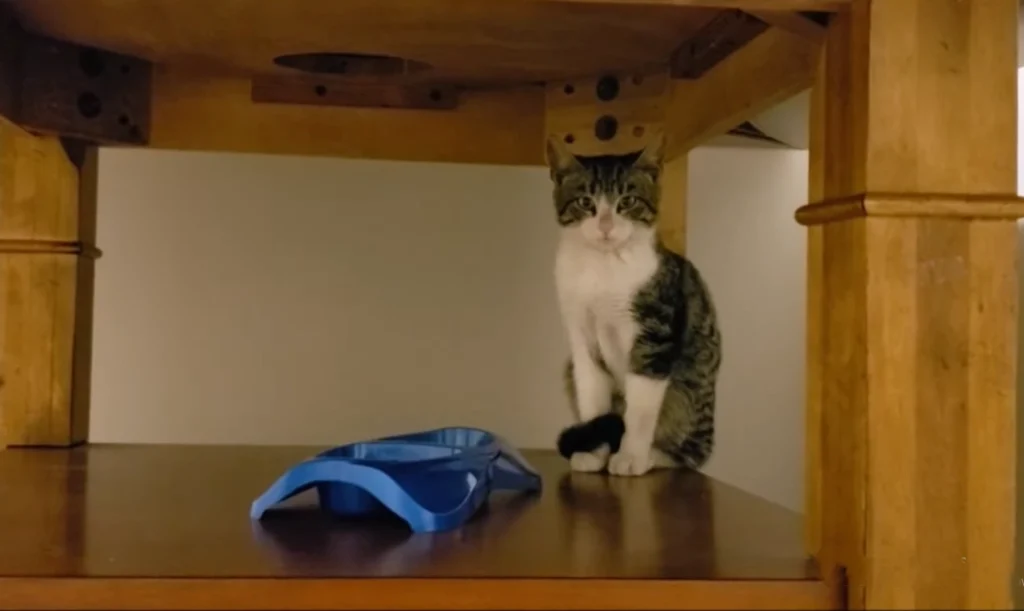How to Tame a Wild Kitten: Essential Steps for Successful Socialization
By: Elizabeth Rikas

The information in this article is intended to educate cat parents and is not a substitute for veterinary guidance. In case of any concerns about your cat’s health, please talk with your veterinarian.
Taming a wild kitten can seem like a daunting task, but with the right approach, it can be a rewarding experience. To successfully tame a wild kitten, one must focus on creating a safe and welcoming environment while using gentle techniques to bond with the kitten. Understanding feline behavior is crucial, as it helps to build trust and allows the kitten to feel secure in its new home.
Many people may think that handling a feral cat is impossible, but with patience and consistent effort, these little creatures can learn to love human interaction. By taking small steps and allowing the kitten to come to them, individuals can establish a connection that leads to a happy and playful pet. The journey to taming a wild kitten requires commitment, but the resulting companionship is often worth the effort.
Key Takeaways:
- A safe environment is essential for taming a wild kitten.
- Gentle bonding techniques help build trust with the kitten.
- Patience is key for a successful transformation from feral to friendly.
Related Read: Best age to declaw a cat
Understanding Feline Behavior
Recognizing how feral kittens behave is crucial for successful taming. Their actions and reactions are shaped by their experiences and environment. Understanding these behaviors helps foster a better connection with them.
The Nature of Feral Kittens
Feral kittens are wild and born without human contact. They often see humans as threats rather than friends. Their instincts drive them to be cautious and elusive.
When first approached, they may hiss, growl, or run away. This reaction is typical of their survival instincts. Over time, with gentle handling, they can learn to trust.
Socializing feral kittens requires patience and understanding of their fears. Since they rely on natural instincts, conditioning them to accept human presence can take time. Each kitten has a unique background, affecting how quickly they adjust.
Differences Between Feral and Stray Cats
Feral cats are typically born in the wild and have minimal interaction with humans. Stray cats, on the other hand, have often had previous contact with people. This difference greatly affects their behavior and personality.
Stray cats tend to be more social and may approach humans easily. Feral kittens usually require more time to acclimate. Strays might meow for attention, while ferals may avoid interactions altogether.
Understanding these differences helps in deciding how to approach each type. Knowing that feral kittens will likely need gradual socialization is essential for successful taming.
Click to explore: How To Make Cats’ Fur Softer
Key Personality Traits of a Wild Kitten
Wild kittens often show a mix of curiosity and fear. They are naturally playful but remain cautious about new experiences. Their instinct to hide and observe plays a significant role in their interactions.
These kittens can be very sensitive to sounds and movement. Sudden changes can frighten them, leading to defensive behaviors.
Through positive reinforcement and patience, their playful nature can emerge. Trust builds as they observe consistent, gentle handling. Each interaction shapes their development and personality.
Recognizing these key traits can facilitate the socialization process. Understanding how wild kittens think allows caregivers to provide a supportive environment for growth.
Creating a Safe and Welcoming Environment
Providing a safe and welcoming environment is essential for taming a wild kitten. This section focuses on setting up a comfortable space, introducing a litter box, and gradually exposing the kitten to human contact.
Setting Up a Comfortable Space
To create a comfortable space, select a quiet room away from noise and distractions. Use a small area like a bathroom or a cozy crate to restrict its environment. This limits stress for the kitten.
Include soft bedding, like a blanket or a small bed, to give it a sense of security. Ensure the area is warm and inviting. Place food and water bowls nearby, but keep them separate from the sleeping area to mimic natural habits.
Adding some toys can encourage playful behavior. Simple items like balls or feather wands can help engage the kitten. It’s important to avoid overwhelming it. Keep interactions gentle and calm to build trust.
Click to learn about: Split Claws In Cats
Introducing the Litter Box
The litter box is a key part of the kitten’s comfort. Set up the box in a private area, away from food and sleeping spots. Use unscented litter to avoid irritation.
Show the kitten the litter box after meals. Gently place it inside if necessary to help it understand where to go. Consistency is important. Clean the box daily to maintain a fresh environment.
If the kitten does not use the litter box right away, be patient. Encourage it by placing it inside the box after meals or naps. Avoid punishment, as this can create fear.
Gradual Exposure to Human Contact
Building trust takes time. Start by visiting the kitten’s space frequently. Speak softly and calmly to help it get used to the sound of a human voice. Avoid sudden movements.
Once the kitten seems comfortable, offer treats to encourage closer interactions. Gradually extend a hand, allowing the kitten to approach at its own pace. Offering toys can also promote playful engagement.
Signs of comfort include purring or playful behavior. If the kitten hisses or backs away, give it space. Respecting its boundaries is vital for building a positive relationship.
Taming and Bonding Techniques
Taming a wild kitten requires specific techniques to help build trust and create a strong bond. Key strategies include patience, play, and proper handling. Each of these elements contributes significantly to the kitten’s comfort and willingness to connect.
Click to learn: Why is my cat breathing rapidly?
The Importance of Patience and Consistency
Patience is crucial when taming feral kittens. These animals may take time to adjust to their new environment and humans. It is important to allow the kitten to explore at its own pace.
Consistency in approach helps build trust. Daily routines, such as feeding and playtime, create a sense of security. Keeping interactions calm and predictable will help the kitten feel less anxious.
Kittens may also respond positively to gentle tones and slow movements. Avoid sudden gestures that might frighten them. Showing understanding and empathy will encourage the kitten to come out of its shell.
Using Play to Build Trust
Play is one of the most effective ways to bond with a wild kitten. Engaging in playful activities allows the kitten to express its natural instincts while building confidence. Toys like string, feathers, or balls can encourage interaction.
When playing, it’s important to observe the kitten’s preferences. Some might enjoy chasing while others prefer pouncing. Finding the right toy and activity will help foster a positive relationship.
Creating a fun environment not only entertains the kitten but promotes socialization, making it comfortable with human presence. Regular play sessions can significantly speed up the taming process.
Petting and Handling Tips
Introducing petting gradually is essential. Start by allowing the kitten to initiate contact. This could be through close proximity or sniffing. Once she seems comfortable, gentle strokes along the back can be introduced.
When handling the kitten, support its body well. Use both hands, cradling the kitten to provide a sense of safety. Keep handling short initially and gradually increase the duration as trust builds.
Always watch for signs of discomfort, such as hissing or low growls. Respecting the kitten’s boundaries is key. Positive reinforcement, like treats, can also make handling enjoyable and foster a stronger bond.
Click to know what is: Fever Coat In Kittens
Adoption and Transition to Domestic Life
Adopting a wild kitten involves careful consideration and planning to ensure a smooth transition into domestic life. This includes assessing the kitten’s readiness for adoption and integrating it into a home with other pets.
Assessing Readiness for Adoption
Before adopting a wild kitten, it is crucial to assess its readiness. Kittens that are around 8 to 12 weeks old generally adapt better to home life. At this age, they begin to socialize and can learn to trust humans.
Signs that a kitten is ready for adoption include curiosity about human presence, a willingness to play, and a healthy appetite. If a kitten shows extreme fear or aggression, it may require more time to adjust.
Adopters should also consider the kitten’s temperament. A calm, curious kitten is more likely to adapt well to a household setting. Adopting a kitten that is already starting to adjust to human interaction will lead to a smoother transition.
Integrating into Households with Other Pets
Bringing a wild kitten into a home with existing pets requires careful introduction. First, ensure that all pets are vaccinated and healthy. This reduces the risk of illness spreading among animals.
Introduce the kitten gradually. Start by allowing the kitten to explore a separate space while letting other pets sniff around the closed door. After a few days, supervised meetings can help.
During initial interactions, it’s essential to monitor body language. Signs of stress or aggression should be addressed immediately. Use treats and toys to create positive associations between the new kitten and existing pets.
Patience is important in this process. Adjustments can take time, but a peaceful coexistence can be achieved with careful planning and attention.
Frequently Asked Questions
This section addresses common questions about taming wild kittens. Understanding these points can help improve the experience for both the caregiver and the kitten.
Conclusion
Taming a wild kitten is a journey that demands patience, understanding, and consistency. By creating a safe space, using gentle bonding techniques, and respecting the kitten’s boundaries, even the most skittish feral kitten can learn to trust humans. The process may take time, but the reward—a loving, socialized companion—makes every effort worthwhile.
Remember, every kitten is unique, and progress depends on their individual personality and past experiences. Stay patient, celebrate small victories, and let the kitten set the pace. With dedication, you’ll transform a fearful wild kitten into a confident, affectionate pet.

About the Author
Elizabeth Rikas
Elizabeth is a passionate advocate for feline health and well-being, drawing from her years as a dedicated pet parent to three cats—Gypsy, Swan, and Alfred—and her invaluable experience volunteering at animal shelters. A seasoned writer with a lifelong love for cats, Elizabeth began sharing her insights in her teens and has since contributed extensively to platforms focused on feline care. Through her expertise and heartfelt dedication, she empowers pet owners with practical advice and research-backed knowledge to nurture their furry companions.
